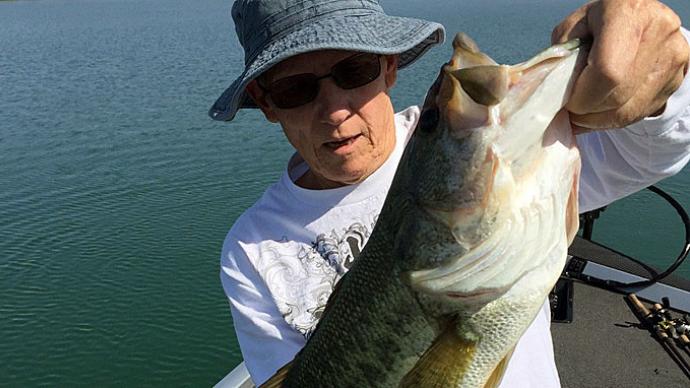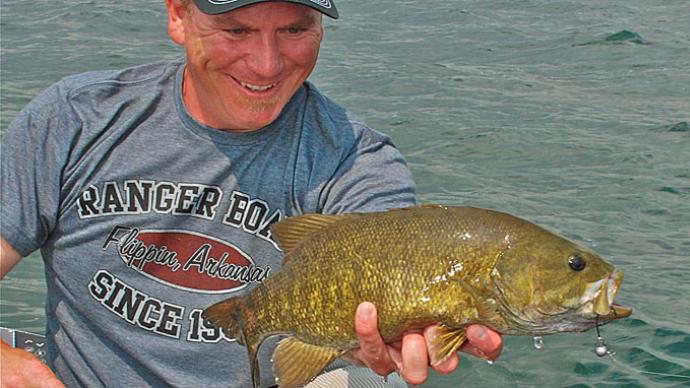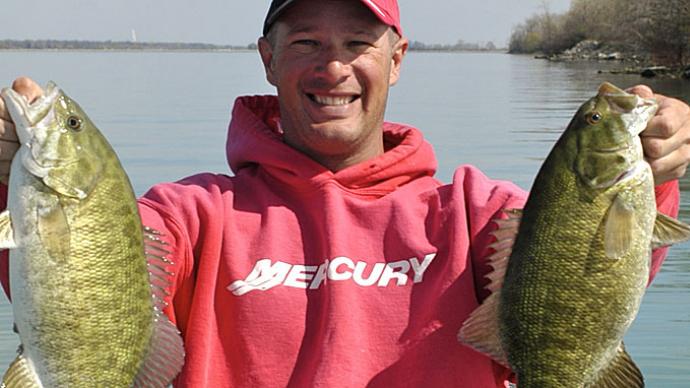
A glorious sunset graces western skies. Walk down to the pond. Peer in the open tackle box. Hmmm. What about a Heddon Tiny Torpedo? Maybe the frog pattern. Run that green thing across water's surface, just beyond those boulders you placed at the corner of the dam. A hit! What fighters! No other species of freshwater fish throws so many lures during mid-jump as smallmouth bass!
In my humble fisheries biologist opinion, smallmouth bass are the champs.
The preceding scenario is true. It's a pleasant June memory, as I sit nestled inside, looking out on 6 inches of fresh white winter blanketing our piece of South Dakota.
Have you considered smallmouth bass in your pond management efforts? I asked Pond Boss editor Bob Lusk his opinion on this fish, and he replied, "Smallmouth bass are completely misunderstood by southern readers, and I suspect slightly underappreciated by northern pond managers."
Let's explore positives along with several myths about this glorious fish.
Throughout this article, I want to distinguish between a couple of pond types. "Gravel pit" describes a quarry-type situation where sand, gravel, or rock has been removed. Often, excavation penetrates ground water, and pits become inundated. In contrast, I'll use the term "hill pond" to distinguish ponds created by building dams on small watersheds, filled from rainfall.
Remember the term "recruitment." A simple definition is, "reproduction and survival to adulthood." The main point that a budding pondmeister must understand is that it's not enough for fish just to reproduce. Those young fry need to have proper conditions to survive to larger sizes. So, when I say smallmouth bass recruit a strong year class, I will not mean they simply reproduced in large numbers. I mean they reproduced well that year, and substantial numbers of young fish then survived to larger sizes. This is an important concept in fisheries management, and as a professor, it's a point I stress when teaching college students.
Knowing basic life history information for smallmouth bass is key to their management. Comparisons with largemouth bass are helpful too, because some people mistakenly consider the two species having similar habits because largemouths are widespread pond fish.
Smallmouth bass are considerably different than largemouth.
Like largemouth bass, crappies, and sunfishes, smallmouth bass are nest builders. Unlike bluegills, which nest in colonies, smallmouth bass forge solitary nests. A male fans a rocky area with his tail, creating a crater shaped nest. With soft music and candlelight, a female is attracted and deposits her eggs. Well, the smallmouth bass version of romance, anyhow. The male fertilizes eggs as they flow, then guards the nest to prevent predation from nest raiders. Like a sentry, daddy continues guarding his nest when eggs hatch into yolk-sac fry. After a few days clustered in the bowl of the nest absorbing their yolk sac, fry will "swim up" in a large school of several thousand. The male will be nearby, guarding young fry from predators, until the large school of tiny creatures disperses.
Smallmouth bass prefer rocks. In gravel pits, there obviously lies abundant sand, gravel, and rock, plenty of natural enhancement. However, if most rock is small particle size, sand or gravel, making an island of boulders or a rocky point would be well worth your time. Certainly, it would concentrate fish for anglers to find!
Whenever I'm involved with new hill ponds, and smallmouth bass will be part of the stocking program, we always think rock. In South Dakota, for example, the last glaciation period left behind a lot of rock, and many crop fields have a rock pile at some corner. Rocks can be great habitat, placed on pond dams, on points running from shallow to deep water, and for creation of submerged rock islands.
As a working field biologist in Kansas, I learned rocky habitat seemed essential to promote smallmouth bass reproduction. In ponds lacking gravel or rock, we often provided spawning baskets. A few heavy rubber cattle feed tubs, purchased at a local farm supply store, can be filled with gravel and placed in the pond. How deep? That depends somewhat on water clarity. Place a basket in 3 feet of water in productive ponds with 18 inches of transparency, and perhaps 4-6 feet deep in crystal clear ponds.
Comparatively, largemouth bass spawn in these Kansas ponds with or without sand, gravel or rock.
In South Dakota, we may simply have more natural rock in most ponds than much of the country. Consequently, we haven't had problems with smallmouth bass reproduction. Our problems are different. We deal with overpopulation and slow growth, not lack of reproduction and survival of young smallies. So, smallmouth bass reproduction in ponds may differ somewhat from southern to northern ponds. However, my evidence is anecdotal, not necessarily based on solid research.
Interested Pond Boss readers may have heard of the current controversy within the fisheries profession regarding fishing for smallmouth bass during spawn. I suspect there is valid reason for concern in northern, infertile lakes such as the granite shield area in northern states of Michigan and Wisconsin, and southeastern Canada. In those lakes, a handful of male smallmouth bass actually bring off the entire spawn for a single lake. I read one study where seven males successfully nested in one Wisconsin lake. Seven schools of fry were the entire year class for that lake and that year.
Angling for those seven male bass during spawning and the short period while guarding schools of newly hatched fry could indeed hurt recruitment if adults were injured or died from delayed hooking mortality. However, it does not appear that this scenario is widespread in more fertile waters. In the Midwest and South, smallmouths typically produce far more fry than could survive, even in a strong year class. Thus, most Midwestern and Southern state agencies are not regulating smallmouth (or largemouth) bass fishing during the spawn, at least at current levels of angling effort. I'm sure we will have continued discussion and more research on this topic.
For ponds in most parts of the country, don't be afraid to catch and release smallmouth bass during spawning season. We certainly catch and release smallies during the spawning period at several ponds we manage in eastern South Dakota. The primary exception to this theory might be infertile northern ponds. Read your soils. Where soils are fertile, ponds tend to be fertile.
What do smallmouth bass eat? So much depends on geographic location, what is available, and what is vulnerable. Largemouth bass are considerably more piscivorous (fish eaters) than smallmouth bass. Smallmouth bass are noted for feeding on crayfish. Some places, crayfish are the dominant food source. That's not to say bronzebacks won't feed extensively on fishes. Look at Dale Hollow Reservoir on Tennessee's northern border. It has produced some big smallies. Work done by Tennessee Tech University biologists Steve Reeser and Dr. Phil Bettoli indicated threadfin shad and alewives were a large component of smallmouth bass diet in this lake. In fact, fish and insects were equal in the diet of 6-inch and larger smallies, with crayfish much less common in stomach samples.
Fish food habits can be quite complicated.
Even within a population, feeding can vary from location to location. In Lake Oahe, a huge reservoir on the Missouri River, biologist John Lott found smallmouths living along rocky rip-rap on the face of the dam fed primarily on crayfish, while those in a large bay further north fed more on fishes. Interestingly, fish on the dam grew more slowly on the lower quality, lower energy crayfish food source, while those feeding on higher quality fish diet (higher energy) grew faster.
Diets also change seasonally. Two of my former students, Scott Gangl and Dr. Kevin Pope, looked at seasonal changes in smallmouth bass diets in a natural lake in eastern South Dakota. Fish (minnows and darters) were primary diet items for most sizes of large-mouth bass in our early spring sample. After that, diets changed substantially. The smaller size groups (those less than 11 inches) fed mostly on aquaticinsects in summer and fall. For larger size groups, fish and insects declined in the diet as the season progressed, and crayfish became the dominant diet item.
When largemouth bass and smallmouth bass occur in the same water body, almost invariably largemouths consume a greater proportion of fish in their diet than will smallmouths. For example, Drs. Jim Long and Bill Fisher looked at diets of largemouth and smallmouth bass in Skiatook Lake, Oklahoma, a 10,000-acre reservoir in the north-central part of the state. Juvenile and adult largemouth bass primarily ate fish, although juveniles ate quite a few aquatic insects as well.
Adult smallmouth bass ate crayfish and fish. Juvenile smallmouth bass primarily ate insects, with some crayfish and fish in the diet.
Bottom line? Diet analysis is complex, varies from lake to lake, and season to season.
Smallmouth bass are not as piscivorous as largemouth bass.
So, as you find a niche to introduce smallmouth bass into your management game plan, learn their habits, and other fish which compete. Create the best habitat for your fish; make sure you manage their food chain.
Dr. David W. Willis is a professor in the Department of Wildlife and Fisheries Sciences, South Dakota State University in Brookings. He frequents the Pond Boss forum at www.pondboss.com and can be reached there.
Reprinted with permission from Pond Boss Magazine



